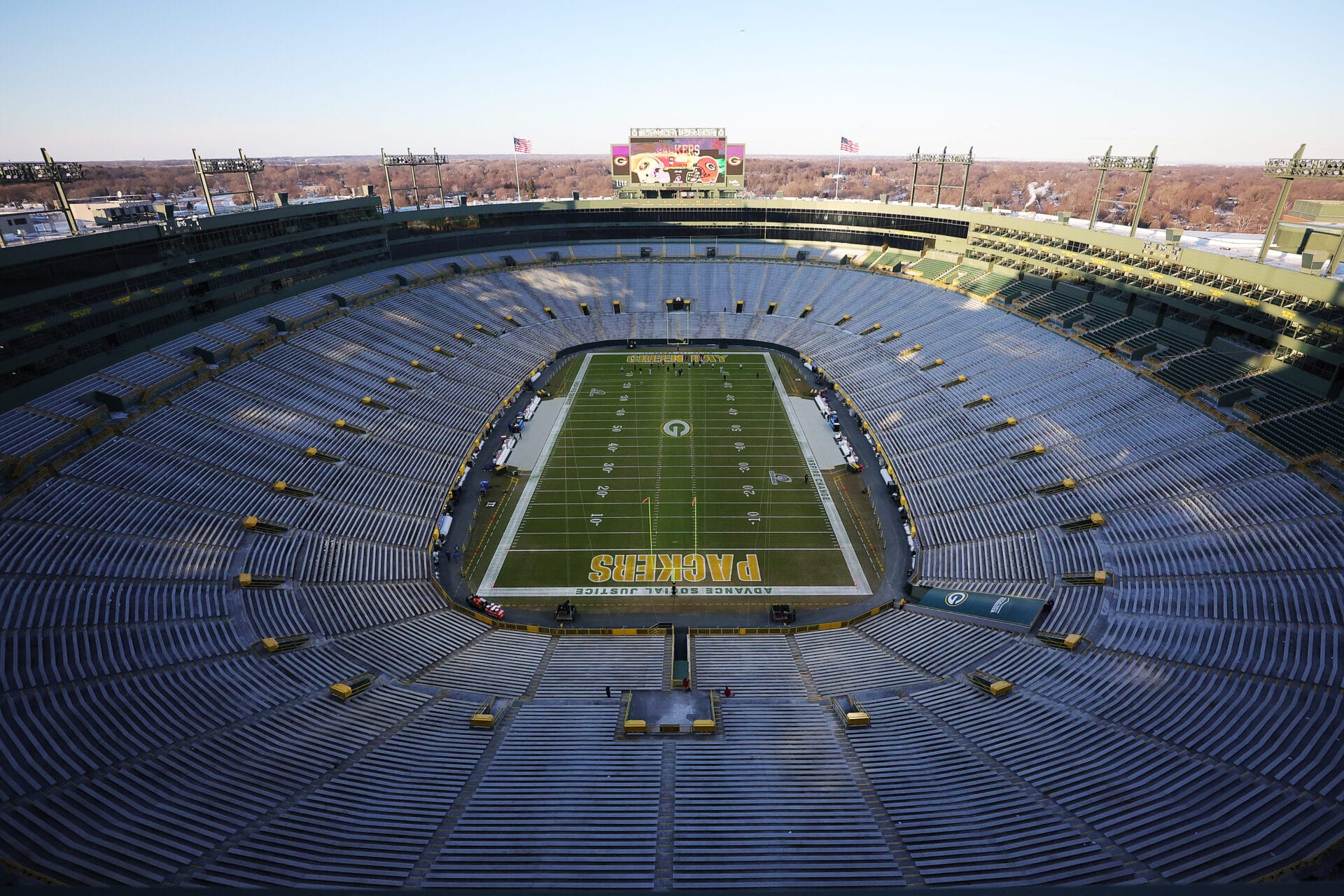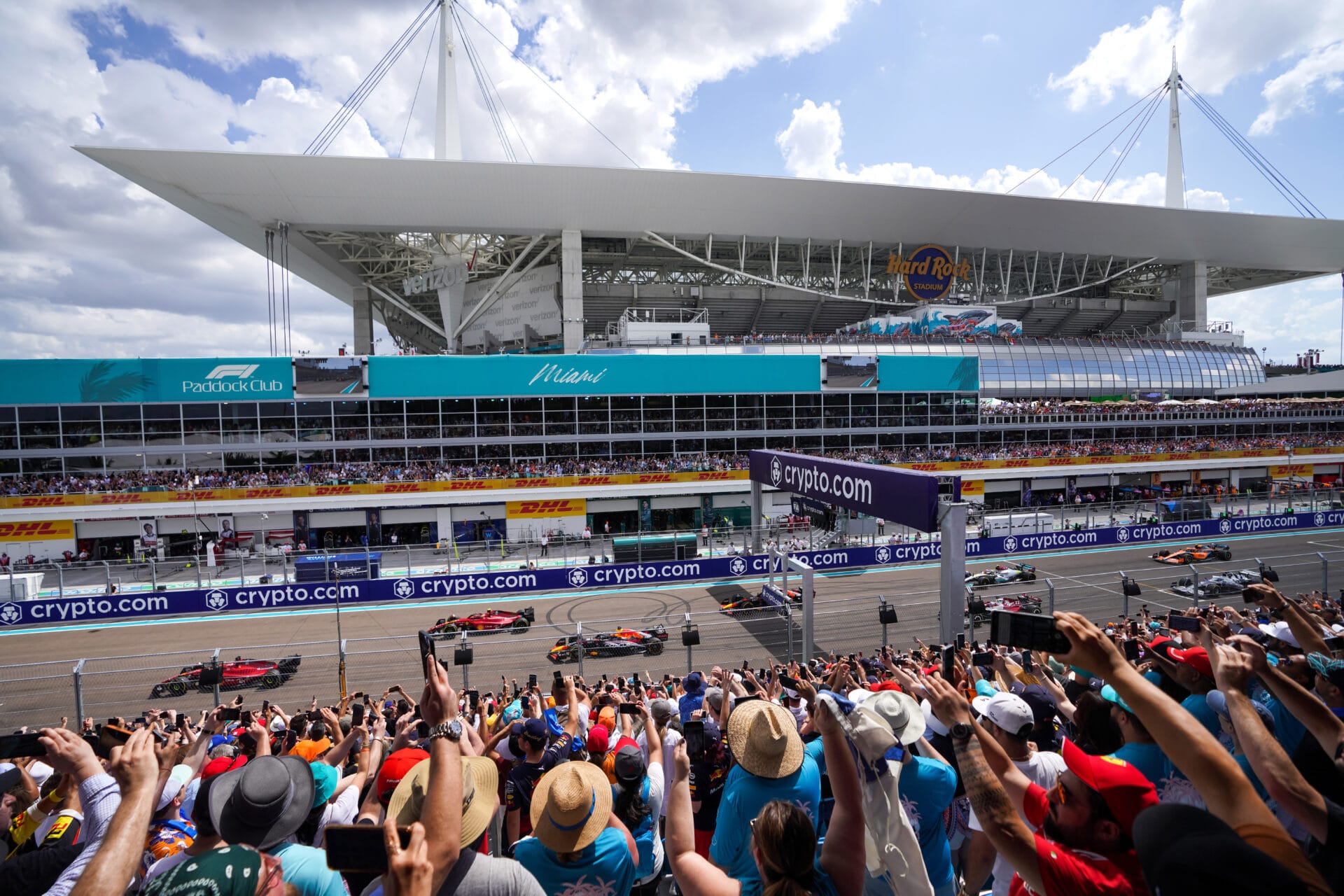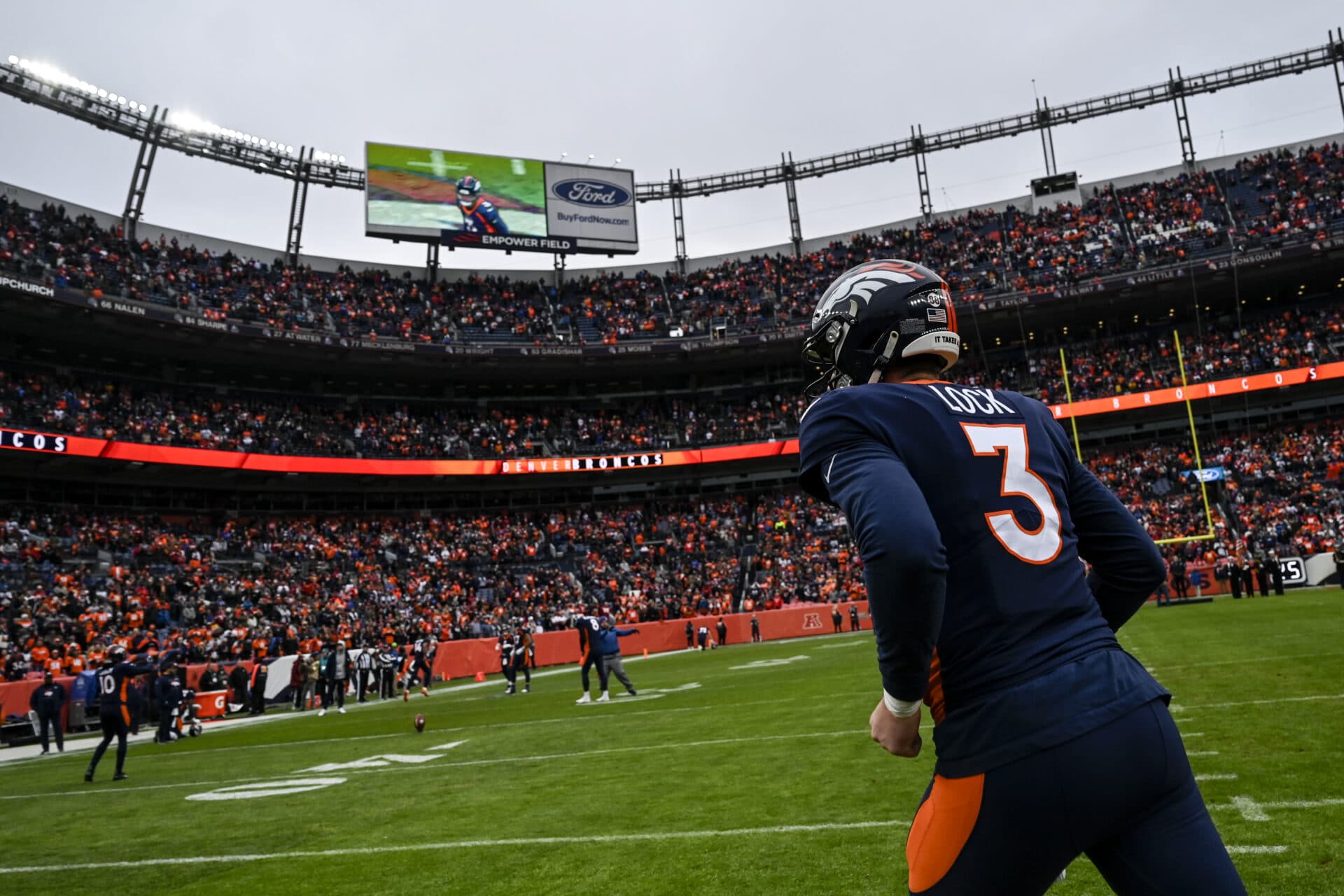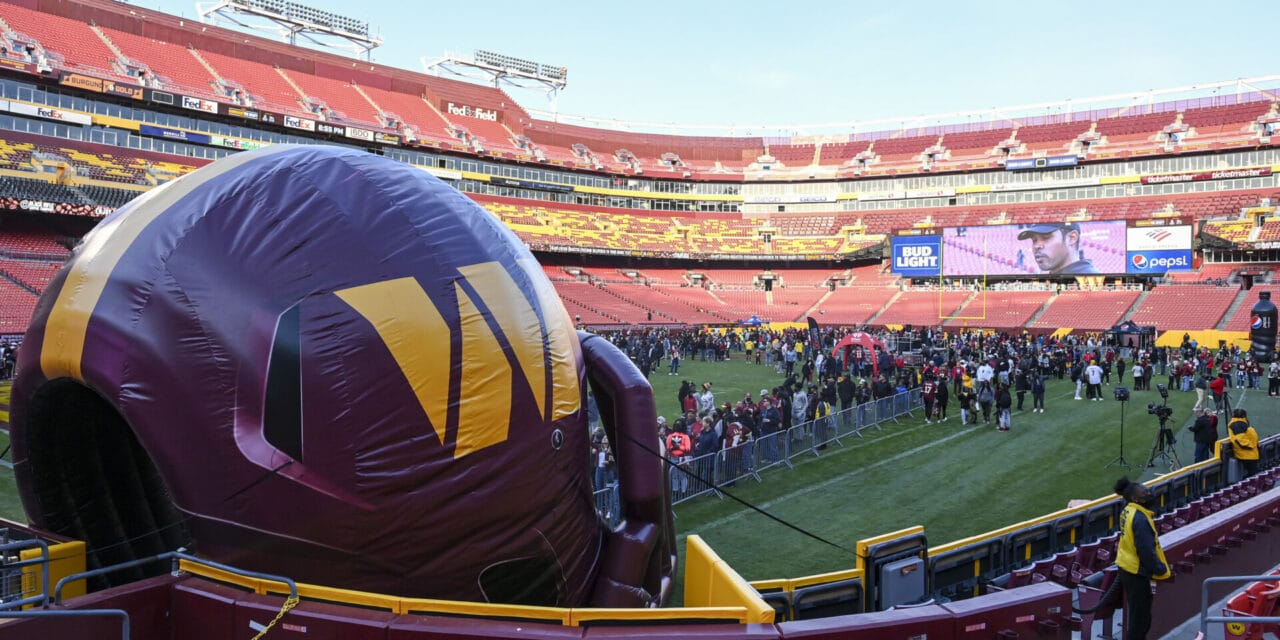IN COMMAND: FedEx Field is shown here playing host to an NFL Draft party in April. The Washington Commanders desire a new stadium with 27,000 fewer seats. (Getty Images)
Teams Weigh Balance Between New Venues And Costly Upgrades
The standard lifespan of an NFL stadium is shrinking to a point far below the typical 30-year benchmark for sports venues, based on about a half-dozen teams striving to build new facilities.
It’s actually dipped below 20 years, considering the $660 million reconstruction of Soldier Field, completed in 2003. It was all new construction except for the historic columns framing the stadium that remained in place. For a few years now, the Chicago Bears have planned for a new stadium at the site of Arlington International Racecourse. Their lease at Soldier Field runs through 2033.
Elsewhere in the NFL, the Carolina Panthers, Denver Broncos, Tennessee Titans and Washington Commanders are in various stages of pursuing new stadiums. Their existing facilities all opened between 1996 and 2001.
Washington owner Dan Snyder started planning for a new stadium in 2014, just 17 years after FedEx Field opened.
What’s driving the trend to build new stadiums barely two decades after NFL teams’ existing venues opened? Several factors are in play, according to seven sports architects with experience designing NFL stadiums.
The emergence of mixed–use developments connected to stadiums, the evolving fan experience, the ability to host the Super Bowl and NCAA Final Four and deferred maintenance at 20-year-old buildings all factor into the equation, they said.
Record inflation in 2022 is another key variable. The Titans decided to build a new stadium in part because they saw a proposed $600 million makeover of 23-year-old Nissan Stadium suddenly double in cost due to higher escalations in raw materials, supply chain issues and a reduced labor force.
“There’s a tipping point when you start spending too much money on an existing building that’s already 20 years old,” said Lanson Nichols, HNTB’s senior vice president of sports architecture. “Are you really buying another 10 to 20 years of life by renovating it? Once you’ve hit the 50% mark, does it make greater sense to build new? Those are tough decisions and there’s no simple answer.”
All of those elements, plus the fact public money is available in certain markets has motivated teams to build new facilities instead of spending hundreds of millions for renovations. Those public sums alone have soared to record highs to help finance sports development.
The Buffalo Bills are getting $850 million in tax revenue — $600 million from the state of New York and $250 million from Erie County — for their new $1.4 billion stadium. They currently play at 49-year-old Highmark Stadium.
The Titans’ deal covers $500 million in revenue bonds backing their project, which could reach $2 billion.
Some designers feel that sense of a shorter shelf life is a misconception. They say it’s more about the necessity for NFL teams to meet the needs of Generation X. It’s no longer your father’s NFL of the 1990s with fewer options for premium seats, sponsor zones and food service.

TENDING TO THE TUNDRA: Over the past 20 years, the Packers have spent roughly $500 million to keep historic Lambeau Field current. (Getty Images)
“There are ownership groups with new money and revenue streams that want to create new experiences to track the next generation,” said Jonathan Mallie, senior principal at Populous involved in designing the Bills’ new $1.4 billion stadium. “It’s not that spaces necessarily have to be redone, but they can become something else and there’s a passion right now for creating these new environments for non gameday events and activating the building for community use. It’s really much more than just a football game.”
Yet, it’s football at the highest level that builds the foundation for these multibillion-dollar developments. For the NFL, that translates to an exclusive group of high-wealth individuals and influencers that compete against each other in the brick-and-mortar space as much as on the field, which, in turn, has helped drive the trend.
“This league is really tight; these owners spend a lot of time together and they benchmark themselves against each other a lot,” said Dan Meis, founder of Meis Architects and the designer of Paul Brown Stadium and Lincoln Financial Field. “The bar has been raised with SoFi Stadium and Allegiant Stadium, which has everybody looking at themselves and saying ‘How do we keep up?’”
Juxtaposed against the arms race for new stadiums are savvy team owners smart enough to keep their buildings current by stretching renovations out over a period of time without waiting until the last minute to address aging infrastructure issues.
The Green Bay Packers, Miami Dolphins, New England Patriots, Pittsburgh Steelers and Detroit Lions have all strategically updated their stadiums over the past 20 years. The Packers alone have spent roughly $500 million over that period of time to keep historic Lambeau Field current, which includes a $300 million expansion in 2003.
Hard Rock Stadium, where the Dolphins play, opened in 1987. From 2015-17, the building underwent a $600 million, privately-funded renovation, transforming it with a roof canopy, 10,000 fewer seats in the upper deck and some of the NFL’s most lavish club lounges.
The project was largely driven by team owner Stephen Ross’ quest to get back in the Super Bowl rotation. Apart from NFL games, the Dolphins have set the bar high for special events by staging professional tennis and Formula 1 racing events next to the stadium. It helps that Ross owns the stadium and the 375-acre property where it sits.
In New Orleans, Louisiana, the Saints and the state of Louisiana partnered on a $450 million overhaul of the Caesars Superdome. The project, to be completed in 2024, comes a dozen years after the dome, built in 1975, underwent $336 million in restorations and renovations after Hurricane Katrina devastated the city.
In Charlotte, North Carolina, Bank of America Stadium has undergone roughly $250 million in upgrades over the past decade, touching virtually every part of a building that opened in 1996. The newest additions are two field level bunker clubs, one of which, The Vault, accommodates FC Charlotte, a new Major League Soccer team.
At the same time, David Tepper, owner of the Panthers and FC Charlotte, desires a new stadium.
“There’s almost no stadiums that can’t be renovated,” said Matt Rossetti, a principal with Rossetti working on a sixth phase of renovations to Lambeau Field and Titletown, the Packers’ entertainment district that opened in 2017. “A lot can be done for half a billion, but a lot of these owners are ‘going for broke’ and the costs get astronomical.”
It’s hard to believe that extensive renovations now equal what it cost to build new stadiums 20 years ago. Still, half a billion is much less than the $1 billion to $2 billion that’s now the standard to build a new venue with all the modern amenities.
Meis Architects, which merged with Perkins Eastman one year ago, is designing smaller upgrades to clubs and refreshing spaces that don’t get used that much at Lumen Field, the Seattle Seahawks’ 19-year-old-home.
Elsewhere, Meis said the numbers are “shocking” for refurbs at Paul Brown Stadium and FirstEnergy Stadium, which opened in 2000 and 1999, respectively.
“Cincinnati and Cleveland are both looking at significant renovations in the $500 million to $600 million range,” he said. “I’m pretty sure that’s what Philly cost when I did that building. The idea that here we are 20 years later and it costs that much to update is frightening.”

HARD EXTRACURRICULARS: The Miami Dolphins have taken non-NFL events to a much higher level at Hard Rock Stadium, which played host to a Formula 1 race in early May. (Getty Images)
In some cases, it’s a matter of NFL stadiums catching up to arenas in terms of the whole hospitality approach, Rossetti said. His firm designed the Palace of Auburn Hills, the old home of the Detroit Pistons and subsequent renovations. The NBA team would “throw a little bit of money every year to add a little lipstick,” he said. Every five to 10 years, they would invest $10 million to $50 million in upgrades. “When you’re entertaining year after year in suites and clubs and other premium products, you want to see something new every so often,” Rossetti said.
That’s part of the issue for NFL stadiums constructed during the building boom of the ‘90s and early 2000s (most designed by the old HOK Sport), said Nate Appleman, vice president and director of HOK’s sports practice. Back then, those projects stood as the first generation of sport-specific facilities after replacing venues that held both NFL and Major League Baseball teams.
Apart from the exteriors, it was essentially the same formula for those open-air buildings. Most had similar seating bowls and premium seat options, a piece of the business that has expanded into multiple forms of loge boxes and other hybrid products, Appleman said.
In addition, fast forward 25 years and NFL teams see the entertainment districts that big league arenas have been successful in expanding their properties into year-round destinations and wonder why they can’t follow the same model, he said.
Building a new stadium with greater flexibility tied to a district drives revenue and increases the value of the franchise. Plus, it’s more amenable for cities providing public dollars for those projects. The tax income generated from a district’s hotels, bars and restaurants “opens the negotiating tables up a little bit,” Appleman said. “That’s really the ‘why’ around a lot of this trend, whether it’s Tennessee or Chicago.”
Add Denver and Washington to the mix. The Broncos have interest in developing a mixed-use project next door to Empower Field or at a different site tied to a new stadium, according to local reports. In early June, the team was sold to Walmart heirs the Walton and Penner families for $4.65 billion, pending league approval.
Nichols is intimately familiar with Empower Field. He was part of the facility’s original design team before working on Levi’s Stadium and Allegiant Stadium. Since Empower Field opened in 2001, Nichols has designed multiple renovations and said the Broncos have taken excellent care of the building. It still has a lot of life to it, he said, but it all depends on the new owner and their vision.
“The best way to sum it up is the ongoing evolution of live entertainment venues,” Nichols said. “You can talk about any of these stadiums and pick it apart and the common thread is keeping things current, driving revenue, fan experience and good infrastructure. You have to stay on par with your peers.”
In May, the Richmond (Virginia) Times-Dispatch reported the Commanders plan to build an enclosed stadium as part of an entertainment district with an amphitheater and an indoor music venue after Snyder acquired land in Virginia, about 25 miles from Washington D.C.
It’s the East Coast version of SoFi Stadium and Hollywood Park in Inglewood, California.

MIXED BAG: The Denver Broncos could pursue a new stadium tied to mixed use under new ownership. (Getty Images)
Mark Williams, a principal at HKS, the firm that designed four of the six newest NFL stadiums, including SoFi, said one of the first conversations his group has with teams is deciding whether the building should be open air or have a roof. Williams said teams recognize the benefits of creating a controlled environment for events apart from NFL games, which produces more revenue.
Fan comfort and the desire to host multiple events are the two biggest drivers for new NFL stadiums, said David Manica, owner of Manica Architecture, a firm hired by the Bears and the Titans to come up with initial design concepts for their new venues. Over the past 20 years, Manica said there’s been a big shift toward enclosed stadiums to secure events such as the Super Bowl and Final Four as well as other events not under the pressure of weather.
“Every project is different,” he said. “The recent success of Allegiant and SoFi have helped drive that thinking.”
Along those lines, the trend for downsizing capacity across most sports is a byproduct of teams pursuing new stadiums. The Bills’ and Commanders’ new stadiums are proposed for 60,000 and 55,000 seats, respectively, far less than Highmark Stadium and FedEx Field.
“Back when we were doing Broncos, there was a state mandated minimum that exceeded old Mile High Stadium by one seat — 76,125 plus one,” Nichols said. “At that point in time, generally the starting size for a stadium was assumed to be 72,000, but it’s been drifting downward slowly. It’s about balancing demand. Part of it is the NFL relaxing the capacity requirement for the Super Bowl.”
Bottom line, NFL team owners pursuing new stadiums hammer the point home with architects that “it’s got to pencil out; the ROI must be there or it’s not the right decision,” Appleman said. “Buildings like State Farm Stadium and NRG Stadium and Mercedes-Benz Stadium went into it consciously, expecting to do multiple events apart from the NFL calendar. It’s the smart thing to do.”







